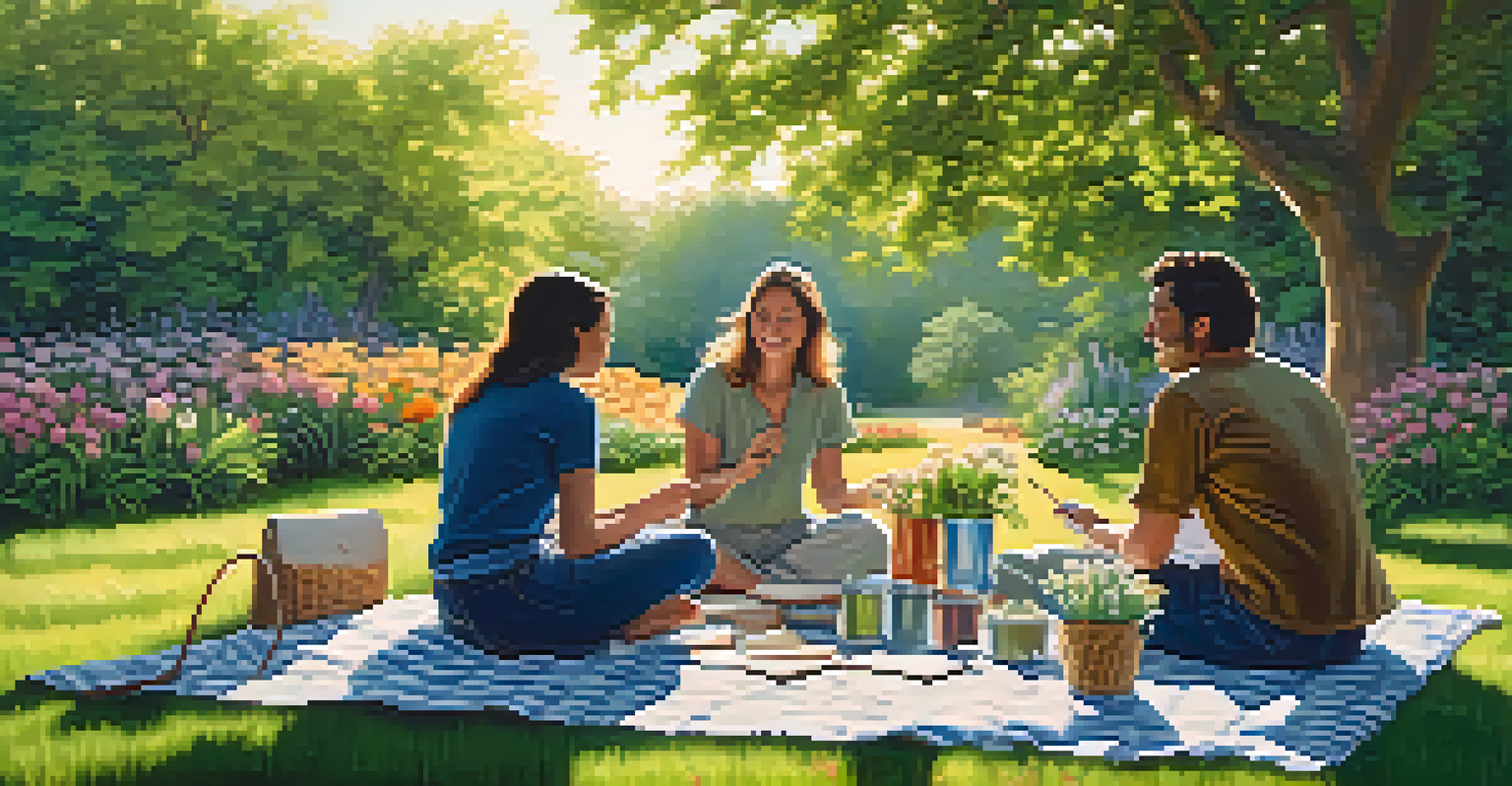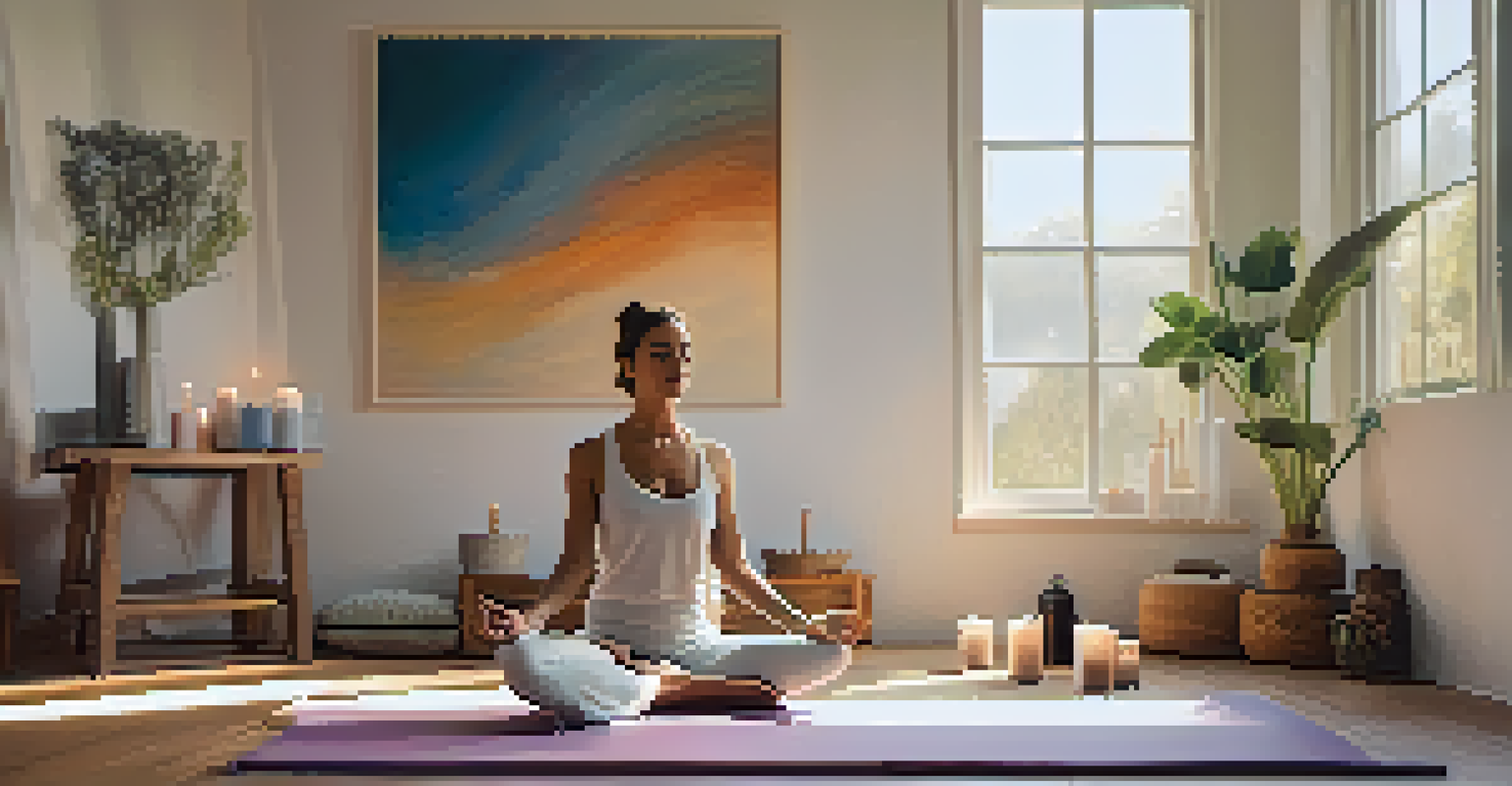The Role of Mindfulness in Creating Art through Yoga Principles

Understanding Mindfulness and Its Importance
Mindfulness is the practice of being present in the moment, focusing on your thoughts, feelings, and surroundings without judgment. This awareness not only enhances mental clarity but also fosters creativity, allowing artists to connect deeply with their work. By incorporating mindfulness into their practice, artists can unlock new perspectives and ideas, leading to a more profound artistic expression.
Mindfulness isn't difficult. What's difficult is to remember to be mindful.
When artists engage in mindfulness, they often find that their creativity flows more freely. This state of awareness helps to quiet the inner critic, making room for spontaneous ideas to emerge. It’s like clearing a cluttered desk; once the distractions are removed, you can focus on the task at hand with renewed energy and inspiration.
Incorporating mindfulness into art can transform the creative process into a joyful exploration rather than a stressful endeavor. As artists become more attuned to their thoughts and feelings, they can channel these experiences into their artwork, creating pieces that resonate on a deeper level with viewers.
Yoga Principles: A Gateway to Mindful Art
Yoga principles, such as breath awareness and intentional movement, can serve as powerful tools for enhancing mindfulness in art. Just as yoga encourages practitioners to connect with their bodies and breath, artists can learn to tune into their creative instincts. This connection allows for a more fluid and natural artistic process, where the act of creating becomes a form of meditation.

For example, practicing deep breathing before starting a painting can help clear the mind and focus energy. This simple act can ground artists, allowing them to enter a state of flow where creativity thrives. Just as yoga practitioners find balance and alignment in their bodies, artists can find harmony in their creative expression.
Mindfulness Enhances Artistic Flow
Practicing mindfulness allows artists to quiet their inner critic and embrace spontaneity, resulting in a more joyful and creative artistic process.
Additionally, the focus on intentional movement in yoga translates beautifully into art-making. Each brushstroke or sculpting motion can become a mindful practice, encouraging artists to be present and engaged with their materials, leading to more authentic creations.
Connecting Body and Mind in the Creative Process
The integration of body awareness through yoga can significantly enhance an artist's creative process. When artists are mindful of their physical sensations, they may discover new ways to express themselves. This connection between body and mind can lead to a richer and more dynamic artistic experience, much like how dancers convey emotion through movement.
The creative process is a process of surrender, not control.
Being aware of your body while creating art can also help prevent tension and discomfort. Just as yoga teaches postural alignment and relaxation, these principles can help artists maintain a comfortable and sustainable practice. This not only improves the physical act of creating but also enhances the overall enjoyment of the process.
Through this holistic approach, artists can cultivate a deeper relationship with their work. By tuning in to both physical and mental states, they can express emotions and ideas that might otherwise remain hidden, resulting in artwork that truly reflects their inner world.
Using Meditation to Spark Creativity
Meditation, a core component of mindfulness and yoga, can serve as a powerful catalyst for creativity. By quieting the mind and focusing on the present moment, artists can clear mental clutter and tap into their innate creative potential. This practice encourages divergent thinking, which is essential for generating new ideas and perspectives.
For instance, a simple meditation session before starting a creative project can invite clarity and inspiration. Artists may find that by allowing their minds to wander freely during meditation, they stumble upon unique concepts and approaches that they wouldn't have considered otherwise. It’s like giving your mind permission to play, leading to unexpected and delightful artistic discoveries.
Yoga Principles Foster Creativity
Integrating yoga principles like breath awareness and intentional movement helps artists connect with their bodies and enhances their creative expression.
Moreover, regular meditation can build resilience against creative blocks. As artists learn to observe their thoughts without attachment, they become better equipped to navigate challenges and setbacks, ultimately enhancing their creative journey.
The Role of Ritual in Art and Yoga Practices
Rituals play a significant role in both yoga and artistic practices, helping to create a sacred space for creation. Establishing a consistent routine can signal to the mind and body that it's time to engage in creative work. This sense of structure can help artists transition into a mindful state and enhance focus.
For example, an artist might begin each session by rolling out their yoga mat, practicing a few poses, and setting an intention for their art. This ritual not only prepares the body but also aligns the mind, paving the way for a productive and inspired creative session. It’s like creating a personal sanctuary where creativity can flourish.
Additionally, incorporating elements like music, scent, or specific tools can deepen this ritualistic experience. By choosing items that resonate personally, artists can create a sensory environment that fosters mindfulness and creativity, turning the act of creating into a cherished ritual.
Embracing Imperfection and the Journey of Creation
One of the beautiful teachings of both mindfulness and yoga is the acceptance of imperfection. Artists often grapple with the desire for perfection, which can stifle creativity. Through mindfulness, artists learn to embrace their mistakes as part of the creative journey, leading to growth and exploration.
This perspective shift can be likened to yoga, where the focus is on the process rather than the end result. Just as each yoga pose is an opportunity for self-discovery, every brushstroke or sculpted form can be seen as a step in the artist's journey. This mindset encourages experimentation and playfulness, opening the door to new possibilities.
Community Amplifies Mindful Art
Collaborative art practices within a mindful community nurture support and connection, enriching individual creativity and fostering collective artistic growth.
By letting go of the need for perfection, artists can engage more fully with their work. This freedom fosters innovation, allowing them to create unique pieces that reflect their authentic selves, resonating with audiences on a deeper level.
Cultivating a Mindful Community Through Art and Yoga
Creating art within a mindful community can amplify the benefits of mindfulness and yoga principles. When artists come together in collaborative environments, they can share experiences and insights, fostering a sense of connection and support. This communal aspect not only enriches individual practice but also nurtures collective creativity.
For instance, group art classes that incorporate mindfulness practices can create a safe space for exploration and self-expression. Participants can inspire one another, share techniques, and celebrate each other's growth. This supportive environment can lead to new friendships and collaborations, enhancing the overall artistic journey.

Moreover, community events that blend art and yoga can attract diverse audiences, promoting mindfulness beyond the individual level. By engaging the broader community in these practices, artists can raise awareness about the importance of mindfulness in fostering creativity and well-being.